Box tree moth
Cydalima perspectalis
Appearance
The moth of the boxwood borer reaches a wingspan of 25-30 mm and shows a very characteristic wing pattern. The forewings are colored white and have a broad black-brown band on the anterior margin and border. In the center field a small brown bulge and a crescent-shaped white spot is visible. The white hind wings also have a brown fringe. There are also completely brown colored moths with a white spot.
The caterpillars grow up to 5 cm long, are yellow-green in color and have black and white longitudinal stripes, black spots, white bristles and a black head capsule.
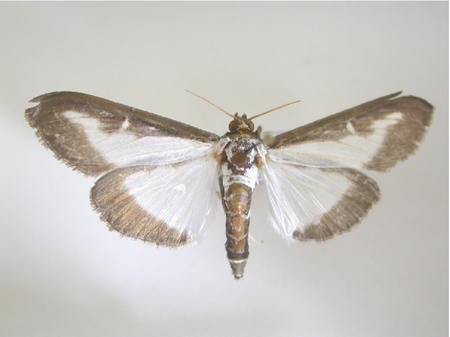
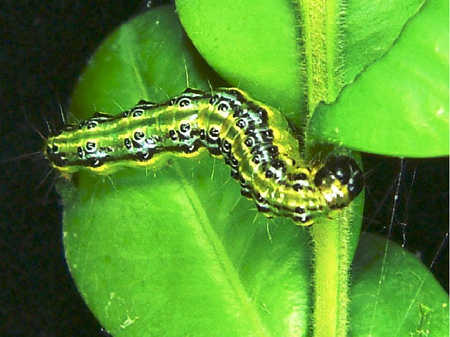
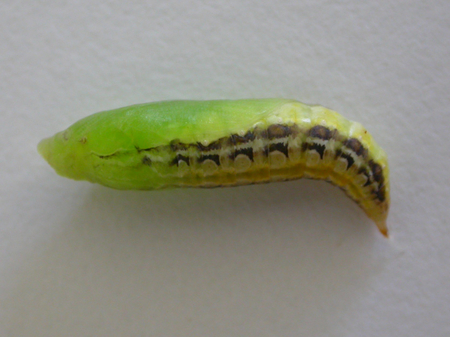
Biology
The boxwood borer Cydalima perspectalis (synonym: Diaphania perspectalis) belongs to the weevil family (Crambidae).
The moths fly from June and lay their shield-shaped yellowish eggs in small groups on the undersides of leaves. The hatching caterpillars live in loose webs and pass through six larval stages, finally reaching a size of up to 5 cm. They pupate in a cocoon on their host plants. After a short period of dormancy, a finished moth hatches from the cocoon. The boxwood borer goes through its development cycle three times in each year - one speaks of three generations.
Hibernation takes place as a caterpillar in a web on the host plants. After overwintering, the caterpillars begin feeding from mid-March to early April.
Damage symptoms
The caterpillars live in loose webs and feed on leaves - initially they cause a scraping feeding on the leaves in the inner or lower part of the plant, which is why they are often overlooked at the beginning of the season. They are capable of completely defoliating their host plant, causing it to die. When food is scarce, they then also feed on the green parts of the bark.
The caterpillars' droppings, which collect in the webs and on the leaves, are also conspicuous.
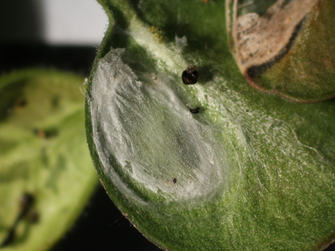
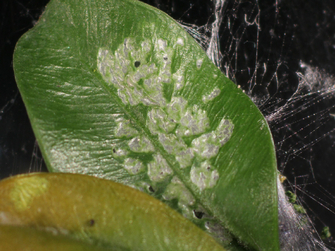
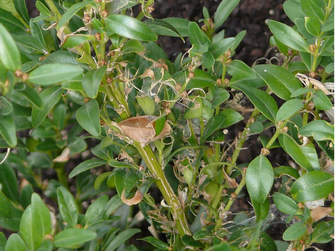
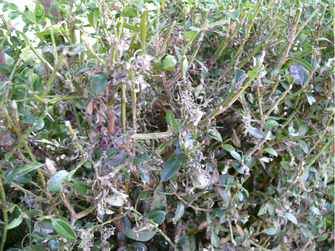
Distribution
The boxwood borer originates from Japan and was first discovered in Europe in 2007 in Germany. From there, it has spread steadily. In Austria, the first occurrence of the boxwood borer was reported in Vorarlberg in 2009. Later, it was also found in Styria and Lower Austria. The pest is now widespread throughout Austria.
Prevention and control
- Do not buy/release infested young plants
- Do not move infested plants to areas free of infestation
- Take particular care in the vicinity of cemeteries, where experience has shown that infested plants are often released
- Regular infestation checks of the inner and lower areas of box trees from March to October
- Check the moth flight using pheromone traps
- Mechanical cutting out of the webs and collection of the larvae with subsequent destruction
- Pruning of infested box trees, preferably after the moth has laid its eggs
- Planting replacement plants such as barberry(Berberis spp.), holly(Ilex spp.) or honeysuckle(Lonicera spp.)
- Spray treatment with an authorised product to control the box tree moth or biting insects and free-feeding butterfly caterpillars in ornamental plant cultivation (see list of plant protection products authorised in Austria)
- The beneficial insect-friendly bacterium Bacillus thuringiensis subsp. kurstaki can be used as a biological plant protection product against young caterpillars
- Apply the spray mixture under high pressure (fan sprayer) and wet all parts of the plant thoroughly
- Encourage natural enemies (e.g. birds). No parasites have yet been detected on box tree moths. As they store the toxins of the box tree in their bodies, they are also poisonous or unattractive to potential predators. However, native songbirds (such as sparrows, tits, ...) have already been observed feeding their young with box tree moth caterpillars.
Last updated: 21.03.2024
automatically translated